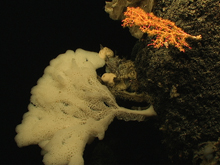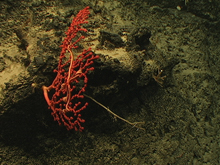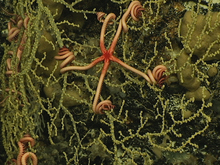
Several brittle stars have their arms wrapped around the branches of an octocorallian sea fan (Plexauridae) at 1120 meters depth in Exuma Sound.
![]() Click image to view a slide show.
Click image to view a slide show.
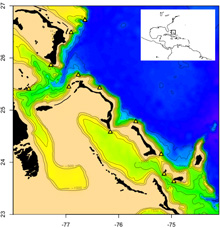
A bathymetric map of the northern Bahamas (inset shows area of detail) with colors indicating different depth zones: blues are deepest (>3000 meters), yellow-to-green intermediate (500-2500 meters), and beige shallowest (<500 meters); islands are shown in black. Our 12 dive sites are indicated by the yellow triangles. (Map figure by Eric Pante) Click image for larger view and image credit.
Deep-water Connections: Probing the Southern Limits of Distribution of North Atlantic Deep-Sea Coral Communities
March 13-31, 2009
Scott C. FranceUniversity of Louisiana at Lafayette
Chief Scientist
Corals in the deep sea? When asked to describe corals, most people think of those that make up tropical, shallow-water reefs like the Great Barrier Reef. There are, however, corals that live in much deeper, colder waters where there is no sunlight. Over the past 8 years, my colleagues and I have been studying these deep-sea corals in North Atlantic waters deeper than 1000 meters. Between 2003-2005, we visited a previously unexplored group of extinct underwater volcanoes in the western North Atlantic—the New England Seamounts and Corner Rise Seamounts ' looking for deep-sea coral communities living between 1000 and 2500 meters depth (see Mountains in the Sea 2004: Exploring the New England Seamount Chain and North Atlantic Stepping Stones 2005 for photos and details). Our explorations revealed some spectacular assemblages of bamboo corals, bubblegum corals, black corals, and a variety of other sea fan and sea whip species. Living with the corals were a myriad of animals, including shrimp, crabs, snake stars, sea stars, feather stars, scale worms and many species of deep-sea fish. Most of the species we found were new to science, while others (or their close relatives) were known only from the eastern North Atlantic and were being observed in the western Atlantic for the first time. As a follow-up to those discoveries, we planned this expedition to explore the deep slopes of the northern Bahamas. In the western North Atlantic, a major deep-sea current flows from north to south along the slope of the continental USA, but as it approaches the tropics, it encounters deep, cold water flowing northward from Antarctica. Our goal is to determine if the coral species, and their associate fauna, living in the subtropical Bahamas are the same as those on the seamounts to the north, or will we begin to see a different group of species reflecting a southern influence?
The corals we study – octocorals, commonly referred to as soft corals, gorgonian corals or sea fans – are colonial animals, that is each colony has dozens to hundreds of feeding structures, called polyps, that have their own mouth and ring of tentacles for capturing prey. Octocorals most often are found attached to a hard bottom [substrate]. Therefore, to find them we must search for places where the water flow is strong enough to keep sediments from accumulating on the sea floor, thus exposing the rocky substrate underneath. We have the best chance of finding these conditions in areas where the sea bottom topography is irregular – or “bumpy” – and steep. Imagine a mighty canyon at a bend in a river – the walls are too steep to hold much dirt, and the water rushing by scours away what little settles. In addition to requiring an exposed hard substrate to settle and grow upon, corals rely on moving water to bring food to them. Since they are permanently attached to the bottom, they cannot chase their prey but rely instead on whatever floats nearby, and the faster the water movement, the more potential food items that may pass by.
To select locations we thought likely to be suitable for coral communities, we studied bathymetric maps of the region (see map figure). We identified three major areas of interest: the mouth of Little Abaco Canyon (north of Abaco Island), the Bahama Escarpment (the steep-walled drop-off from the Bahama Plateau into the North Atlantic Basin), and the San Salvador spur, an underwater feature that juts northward from the Bahama Plateau. Biological communities in these deep-sea areas have never before been explored using modern imaging technologies, such as high definition video.
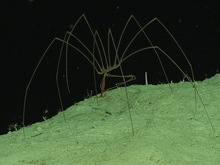
A sea spider (Pycnogonida) creeps along the top of ridge at 1960 meters depth in the Northeast Providence Channel near Eleuthera Island. Click image for larger view and image credit.
The task of observing and sampling deep-sea corals, and the fish and invertebrates that associate with them, at depths exceeding one mile is a complex one that requires the use of highly-specialized technologies. On this expedition we used the remotely-operated vehicle (ROV) Global Explorer ![]()
![]() , which is equipped with a high definition video camera and robotic arm, and was piloted from the deck of the R/V F.G. Walton Smith
, which is equipped with a high definition video camera and robotic arm, and was piloted from the deck of the R/V F.G. Walton Smith ![]()
![]() . Even in the Bahamas, deep-sea water temperatures are cold (<6°C, or 43°F), and so the ROV was also equipped with an insulated collection box to keep collected samples in best condition for genetic analyses.
. Even in the Bahamas, deep-sea water temperatures are cold (<6°C, or 43°F), and so the ROV was also equipped with an insulated collection box to keep collected samples in best condition for genetic analyses.
Sampling in the deep sea is always challenging, and was particularly so given the combination of conditions we encountered on the cruise: complex bottom topography, winds up to 34 knots and ocean swells up to 12 feet high. The ROV pilot has to navigate the ROV, which is tethered to a wire that is dangling more than a mile under the ship. The ship’s crew must hold the vessel in position against surface currents and winds so as not to drag the ROV into an unseen undersea wall. It is a tribute to the R/V F.G. Walton Smith crew and the Oceaneering/DSSI ROV pilots that we were able to complete all of the scheduled dives safely despite some challenging weather conditions, allowing us to make some surprising and important scientific discoveries.
Our most surprising discovery was that of a spectacular wall approximately 300 meters (~1000 feet) tall, found greater than 1 mile deep (between 1635 -1900 meters depth (5395- 6270 feet)) and covered with a diversity of sponges of varying colors, sizes and shapes, and octocorals in high abundance. In most places in the food-poor deep sea, the density of larger animals is quite low, so it was remarkable to see this wall feature covered by so many animals over such a large area.
One of the most important discoveries was the diversity (number of species) of octocorals we found in this region. The study areas were dominated by species from two families of deep-sea corals: bamboo corals (Isididae) and chrysogorgiid corals (Chrysogorgiidae). Even though we explored a relatively small area of the bottom, we estimate we found 14 bamboo coral species and 7 chrysogorgiid coral species, most of which will be new to science. Before this expedition, fewer than a dozen bamboo coral species were known from the entire North Atlantic. One of the reasons we are finding so many previously unknown species is because of the ROV technology we are using to explore. These species are living on sheer vertical walls, under hangs, and rugged topography where net trawls – the method of sampling historically used to obtain deep-sea animals – would likely be lost. Even if trawls were successfully deployed and recovered, some of these corals have fragile skeletons and would be destroyed in a trawl before being recovered on the deck of the ship.
As for our stated objectives, we did find some octocoral and fish species in common with the northern seamounts, some of which were a particular surprise. For example the chrysogorgiid coral Metallogorgia melanotrichos was very common on the seamounts, but had not previously been recorded from the continental margin, and so we thought it was an “offshore” specialist. However, we found many colonies of M. melanotrichos during this expedition, and DNA sequencing by UL Lafayette graduate student Eric Pante shows them to be the same species as those from the seamounts. On the other hand, we have also found many species during this brief expedition that we never saw on the seamounts over 3 separate years of expeditions. These data are preliminary and we expect to find many more surprises as we further analyze the specimens in our respective labs over the next year.




